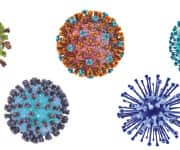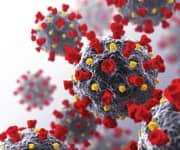Life Extension Magazine®
From the common cold and flu to newer threats, viral infections are a major cause of disease and death worldwide.
The protein lactoferrin has shown potent antiviral activity in preclinical and clinical (human) studies.
It attacks viruses at several points in their lifecycle, through various mechanisms.1-4
While some lactoferrin is produced in the body, it can also be absorbed from oral intake, bolstering the body’s defenses.5
The best ways to avoid viral illnesses remain the standard precautions:
- Avoid contact with sick individuals.
- Wash your hands with soap and water frequently, for at least 20 seconds.
- If soap and water aren’t available, use a hand sanitizer with at least 60% alcohol.
- Avoid touching your eyes, nose, and mouth.
- Clean and disinfect frequently touched objects and surfaces.
Lactoferrin should not replace these tried-and-true preventive measures. However, it may provide an additional layer of defense to reduce the risk of contracting viral illnesses and to diminish their severity.
How Viruses Invade

Viruses are unlike other infectious agents.
For one thing, they cannot grow and reproduce on their own. They must hijack the controls of a host cell to survive and replicate. Also, they are tiny, far smaller than microscopic bacteria and fungi.6
Viruses are made up of miniscule packages of protein that surrounds genetic material. When they find a suitable host cell, they invade, then use that cell to produce new copies of the virus, which can go on to infect other cells.
The first step in this process occurs after the virus enters the body, often through the lining of respiratory airways or the digestive system. Viruses contain surface proteins that are able to recognize specific surface features of cells. This allows them to attach to cells and gain entry.
Once in the cell, the virus takes control of the cellular machinery to make copies of its genetic material and proteins that are then reassembled into new virus particles.
Lactoferrin helps protect by impeding the invasion and growth of viruses at multiple steps in this process.
A Constituent of Mother’s Milk
Lactoferrin is a protein found naturally in milk. It’s also produced in other bodily secretions, including tears and saliva, and by some immune system cells.4
Lactoferrin is found in highest amounts in colostrum, the first type of mother’s milk produced after a baby is born. It has remarkable powers to shield infants from infection before their own immune systems have fully developed.
In adults, it is an important component of defenses against infections.
In mucous, saliva, and other secretions, lactoferrin helps prevent pathogens from gaining entry through the linings of the oral cavity, nasal cavity, airways, and digestive system.
One unusual feature of lactoferrin is the diversity of viruses it can shield against. It has been shown to possess robust antiviral activity against different types of virus, from those that cause the common cold and flu, to HIV and hepatitis B and C viruses.4
Inhibiting Viruses from Entering Cells
The most important way lactoferrin defends against viral infections is by disrupting viruses from binding to cells.1-3,7
This can stop the virus in its tracks, before it has a chance to cause any problems. If the virus cannot attach to and enter cells, it cannot cause illness.
Lactoferrin does this in two different ways:
- It binds to the virus directly, blocking the viruses’ surface proteins’ ability to recognize binding sites on the surface of cell membranes.
- It binds to surface sites on the cell’s outer membrane that are targeted by viruses.
For example, a compound found on cell surfaces, called heparan sulfate, is a common target for various viruses.
Several studies have shown that lactoferrin binds to structures containing heparan sulfate, which can prevent viruses from recognizing and entering the cell.7,8
Activating the Immune System
Lactoferrin also has indirect antiviral effects. It helps the body fight against a virus by activating immune defenses.
Lactoferrin activates natural killer cells and increases their number.5,9 These immune cells are equipped to recognize abnormal cells, including those infected by viruses, and eliminate them. This can help prevent the spread of a virus in the body.
Lactoferrin Defends Against a Wide Range of Viruses

Lactoferrin has been shown in laboratory, animal, and preclinical research to help protect against a huge list of viruses, including:
- Various viruses that cause the common cold,4
- Various viruses that cause flu, including several different strains of influenza A (even the H1N1 subtype that caused a global outbreak in 2009),4,11
- Various viruses that cause gastroenteritis (stomach flu) 4
- Herpes simplex virus,4,12
- Human immunodeficiency virus (HIV), which causes AIDS,1,2,4
- Hepatitis B virus,1,3,8
- Hepatitis C virus,1,2,8
- Cytomegalovirus (CMV),1,4
- Poliovirus,4,8
- Respiratory syncytial virus (RSV),1,11
- Hantavirus,1,11
- Dengue virus, the cause of dengue fever,7,8
- Enteroviruses,2,8
- Echovirus,1,7,8
- Coxsackieviruses,10 and
- Epstein-Barr virus (EBV).12
Lactoferrin also stimulates the production of other antiviral compounds, including the signaling proteins known as interferons.2,4 One of the important ways that interferons promote immunity is to signal to surrounding cells that viruses are present, and help activate antiviral mechanisms to prevent growth and spread of those viruses.
Lactoferrin may also help block the ability of viruses to reproduce even if they’re already inside cells.1,4
This helps limit the spread of the virus, potentially reducing the severity of the resulting illness.
Fighting Common Viral Illnesses
Lactoferrin has been shown, in laboratory, animal, and human studies, to have potent activity against a number of viruses.1-4,7,8,10-12
This includes common viruses such as those that cause the common cold, the flu, and gastroenteritis (stomach flu).
There are several different types and strains of virus that cause these illnesses. Although the common cold and viral gastroenteritis are usually mild, influenza can prove deadly in young children, the elderly, and those with other health issues.
Some strains of the viruses that cause influenza are covered by annual flu vaccines, but many others are not. The extra protection afforded by lactoferrin could make a difference in helping to lessen the impact of these illnesses.
What you need to know

Fighting Viruses with Lactoferrin
- Lactoferrin is a protein produced in milk and bodily secretions like saliva. It’s also produced by some immune system cells.
- Research shows that lactoferrin is active against a wide assortment of viruses.
- Its antiviral activity has been shown to aid in the battle against viruses that cause the common cold, flu, stomach flu, and other illnesses.
- Oral lactoferrin may reduce both the incidence and severity of disease caused by viruses.
In one study, healthy women taking oral lactoferrin experienced a reduced onset of both common-cold-like and gastroenteritis symptoms.13
In other clinical studies, lactoferrin was effective for reducing the symptoms of viral gastroenteritis, including those caused by rotavirus and norovirus. Oral lactoferrin reduced the incidence and severity of the symptoms of these illnesses.4
People taking 100 mg of lactoferrin once a week had approximately 4-times more incidence of viral gastroenteritis compared to people who took it only six or seven days a week.4
Lactoferrin’s Other Immunity-Boosting Benefits

Lactoferrin has benefits beyond fighting viruses.
Studies have demonstrated that it can boost healthy immune function, which protects against a variety of pathogen types.
Various disease-causing bacteria have been found to be susceptible to the actions of lactoferrin.2,3
The immune system is also important in monitoring for abnormal cells which could develop into cancer. Lactoferrin improves this ability, demonstrating potent anticancer effects in many studies.5
Summary

Lactoferrin is a protein produced in milk, saliva, and other secretions.
Laboratory, animal, and clinical research demonstrates lactoferrin’s activity against a wide range of viruses, including those that cause the common cold and flu.
It works by helping to block viral invasion of cells and by amplifying the immune system’s power to eliminate viral infection from the body.
Taken orally, lactoferrin is readily absorbed and can play an important role in bolstering defenses against viral illnesses.
If you have any questions on the scientific content of this article, please call a Life Extension® Wellness Specialist at 1-866-864-3027.
References
- Berlutti F, Pantanella F, Natalizi T, et al. Antiviral properties of lactoferrin--a natural immunity molecule. Molecules. 2011Aug 16;16(8):6992-7018.
- Drago-Serrano ME, Campos-Rodriguez R, Carrero JC, et al. Lactoferrin: Balancing Ups and Downs of Inflammation Due to Microbial Infections. Int J Mol Sci. 2017 Mar 1;18(3).
- Moreno-Exposito L, Illescas-Montes R, Melguizo-Rodriguez L, et al. Multifunctional capacity and therapeutic potential of lactoferrin. Life Sci. 2018 Feb 15;195:61-4.
- Wakabayashi H, Oda H, Yamauchi K, et al. Lactoferrin for prevention of common viral infections. J Infect Chemother. 2014 Nov;20(11):666-71.
- Zhang Y, Lima CF, Rodrigues LR. Anticancer effects of lactoferrin: underlying mechanisms and future trends in cancer therapy. Nutr Rev. 2014 Dec;72(12):763-73.
- Available at: https://www.ncbi.nlm.nih.gov/books/NBK8149/. Accessed March 26, 2020.
- Chien YJ, Chen WJ, Hsu WL, Chiou SS. Bovine lactoferrin inhibits Japanese encephalitis virus by binding to heparan sulfate and receptor for low density lipoprotein. Virology. 2008;379(1):143-151.
- Chen JM, Fan YC, Lin JW, et al. Bovine Lactoferrin Inhibits Dengue Virus Infectivity by Interacting with Heparan Sulfate, Low-Density Lipoprotein Receptor, and DC-SIGN. Int J Mol Sci. 2017 Sep 12;18(9).
- Kuhara T, Yamauchi K, Tamura Y, et al. Oral administration of lactoferrin increases NK cell activity in mice via increased production of IL-18 and type I IFN in the small intestine. J Interferon Cytokine Res. 2006 Jul;26(7):489-99.
- Pietrantoni A, Di Biase AM, Tinari A, et al. Bovine lactoferrin inhibits adenovirus infection by interacting with viral structural polypeptides. Antimicrob Agents Chemother. 2003 Aug;47(8):2688-91.
- Scala MC, Sala M, Pietrantoni A, et al. Lactoferrin-derived Peptides Active towards Influenza: Identification of Three Potent Tetrapeptide Inhibitors. Sci Rep. 2017 Sep 6;7(1):10593.
- Zheng Y, Zhang W, Ye Q, et al. Inhibition of Epstein-Barr virus infection by lactoferrin. J Innate Immun. 2012;4(4):387-98.
- Oda H, Nakano M, Wakabayashi H, et al. Questionnaire survey on the subjective effects of a lactoferrin supplement. Jpn J Complement Altern Med. 2012;9(2):121-8.

